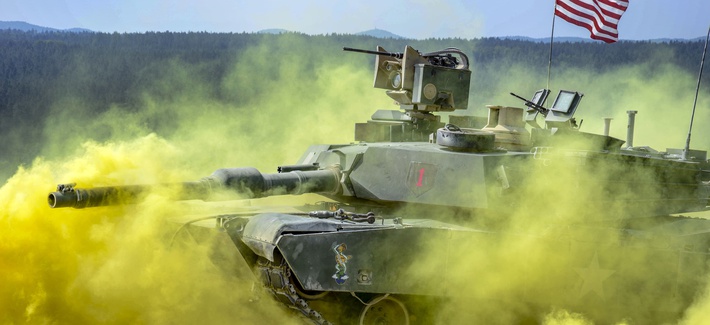BY LAUREN FISH
 You fix the roof when it’s sunny, says U.S. Army Secretary Mark Esper, pointing to his service’s various efforts to improve doctrine and gear during a relative lull in fighting. The Army has more funds and a clear strategy for new vehicles and equipment, the two-year-old Rapid Capabilities Office, and a brand-new Futures Command. Most interestingly, it has a new operating concept dubbed Multi-Domain Operations. Intended to advance combined arms concepts into all the domains of 21st-century war, the MDO envisions new ways the services should jointly operate, identifies new battlefield requirements, and responds to possible pitfalls in the current way the Joint Force does business. Even the name — recently changed from “multi-domain battle” — reflects the notion that future conflicts will feature forms of competition far removed from traditional kinetic combat.
You fix the roof when it’s sunny, says U.S. Army Secretary Mark Esper, pointing to his service’s various efforts to improve doctrine and gear during a relative lull in fighting. The Army has more funds and a clear strategy for new vehicles and equipment, the two-year-old Rapid Capabilities Office, and a brand-new Futures Command. Most interestingly, it has a new operating concept dubbed Multi-Domain Operations. Intended to advance combined arms concepts into all the domains of 21st-century war, the MDO envisions new ways the services should jointly operate, identifies new battlefield requirements, and responds to possible pitfalls in the current way the Joint Force does business. Even the name — recently changed from “multi-domain battle” — reflects the notion that future conflicts will feature forms of competition far removed from traditional kinetic combat.
As the Army hones its ideas, it should heed lessons from a similar “sunny day” nearly a century ago: the interwar years. Among them:
Technology alone doesn’t solve problems. The French used the interwar years to build the technologically advanced Maginot Line, which the Germans simply drove around in 1940. (Nor did the French anticipate that aircraft would provide cover for maneuver in the place of artillery at the crossing of the Meuse, a costly miscalculation.) Technology matters but so do concepts of operation.
Advancing capabilities requires self-critical experimentation.Plenty of countries had tanks at the start of World War II, but Germany excelled at experimenting with them. Williamson Murray observes that over the course of prewar preparations, the Germans continued to adapt and change the organization and use of their panzer and mechanized units, relying heavily on continuous after-action reporting throughout training. Efforts today to introduce rapid prototyping should not be viewed as an end in themselves but the best way to quickly experiment with integrating new technology at new levels and in new ways, as is currently underway with electronic warfare capabilities in Europe.
New ways of using technology can stun an adversary. As Meir Finkel argues, the French were stunned by the German invasion through the Ardennes, but this surprise was not rooted in being ignorant of German technology, but “from the Germans’ method of employing them.” Technologies new and old can be used in new ways that require adversaries to adjust. The French war minister later lamented the prewar French Army focused too much on “textbook solutions” rather than forcing leaders to respond to “unanticipated problems.” The Army should be seeking out opportunities to experiment and brainstorm unforeseen challenges. Gen. Robert Brown, commander of Army forces in the renamed IndoPacific Command, has identified that the operational environment requires new ways of thinking, even arguing “the basics have changed.”
Current conflicts display hints about the future. Lawrence Freedman’s new book The Future of Warfare: A Historydescribes how military thinkers have envisioned future conflicts over time, and shows that war rarely occurs exactly as imagined. Still, careful analysis of current conflicts will provide insight into needed capabilities for the future and the relative merits of different types of engagements. During the interwar years, the Germans and the Soviets showed greater interest in learning lessons from the Spanish civil war than the French, limiting France’s preparedness for the war to come.
This task is even more complicated for the U.S. military today. As TRADOC’s Gen. David Perkins wrote last year, the developers of AirLand Battle could study a clearly defined enemy. Today, threats are unclear – to say nothing of adversary intentions and capabilities. However, the Army should continue to look at recent conflicts (in Ukraine), or lack thereof (South China Sea), that give indications about future warfare. An exquisite future weapon won’t stop Chinese militarization of disputed territory, for example, so the military needs to be sure it can respond to unconventional challenges that may materialize, not only those that are traditional.
Adm. Harry Harris, the recently retired commander of then-Pacific Command, pushed his organization to embrace the concept, instituting joint exercises and instilling the thinking throughout the organization. Facing multiple threats in the theater from the Korean peninsula to the disputed islands in the South China Sea, each service has a role in the theater. This embrace of the concept demonstrates the value multi-domain operations provides in a framework for innovative thinking that can prepare the Joint Force for possible future conflicts.
During this “sunny day,” the U.S. military should continue the full suite of forward-leaning initiatives like those the Army has undertaken, but it should prioritize those efforts that advance critical thinking, learning, and preparedness for future conflicts rather than counting new technology efforts as a sufficient condition.

No comments:
Post a Comment